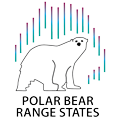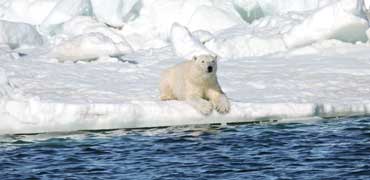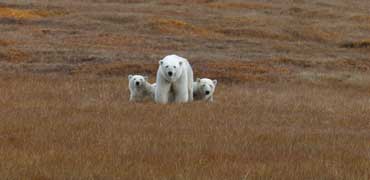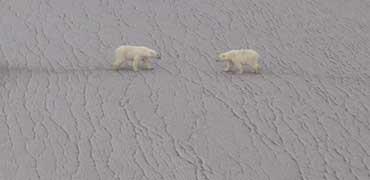“RECOGNIZE the importance and value of Traditional Ecological Knowledge in informing management decisions and ACKNOWLEDGE the need for the range states to develop a common understanding of what constitutes Traditional Ecological Knowledge and how it should be used in polar bear management decisions. “
2013 Ministerial Declaration of Representatives of the Parties
This Plan provides for the active participation of indigenous peoples in polar bear conservation. Indigenous peoples are represented by various ethnic groups in the circumpolar region. For many indigenous peoples living in Canada, Greenland, Chukotka (Russia), and Alaska (U.S.) the polar bear is a significant source of food and clothing and also contributes to the social, cultural, and in some instances, economic well-being of the communities. The Range States recognize the subsistence needs of Arctic indigenous peoples and understand that polar bear conservation will be best achieved by engaging such communities in management decision-making processes. In addition, in Canada, the implementation of Land Claims Agreements with some Aboriginal groups over the past 30 years has resulted in co-management arrangements that involve governments and Wildlife Management Boards working together. Similarly in the United States, cooperative agreements may be entered into between the federal government and Alaska Native organizations to conserve polar bears and provide co-management subsistence use by Alaska Natives.
Participation of Indigenous Peoples
The majority of polar bear research and management around the circumpolar Arctic is based upon scientific results. Indeed, the Range States formally recognize the IUCN/SSC PBSG as their scientific advisory body and rely upon this group for scientific information and advice. However, as previously stated, the Range States also recognize that the polar bear is important to Arctic local people and that their engagement in management and conservation is essential.
Indigenous peoples observe polar bears year round: while out on the land engaging in hunting activities, while traveling, and in their home communities. Their historic and current knowledge can contribute to effective polar bear management and provide insight into animal behavior, population and denning distribution and ecology. In addition, the participation of indigenous peoples in scientific research and monitoring activities can be beneficial. The knowledge of experienced indigenous hunters can contribute to the collective body of knowledge of the health, reproductive rates, survival rates and diet of polar bears. Traditional Ecological Knowledge (TEK) acquisition can contribute to scientific hypotheses and aid in the interpretation of scientific research and the establishment of research priorities.
Definition of Traditional Ecological Knowledge (TEK)
The Range States definition of Traditional Ecological Knowledge (TEK) was created to be inclusive, public, and harmonized with other official definitions. The definition is intended to provide the Range States TEK working group members and other stakeholders involved in the implementation of the Circumpolar Action Plan for Polar Bears (CAP) guidance when considering TEK as part of polar bear research and management initiatives. It was established with the knowledge that other definitions were consulted and analyzed before this one was chosen and is offered in a spirit of respect which has been inspired by the definition of TEK from the Arctic Council. It is not intended to override or replace guidance offered by Indigenous peoples and the Range States acknowledge that other expressions such as Indigenous Knowledge (IK) and Traditional Knowledge (TK) are preferred in some contexts.
Range States Traditional Ecological Knowledge Definition: “Traditional Ecological Knowledge (TEK) refers to a cumulative body of knowledge about the relationships of living beings with one another and with their environment, which is generated from the cultural practices, lived experiences and traditions of local and Indigenous peoples. TEK is specific to place, usually transmitted orally, and rooted in the experience of multiple generations including those most recent. It is a holistic and evolving body of knowledge that includes empirical observations about the environment, factual knowledge about past and current use of the environment, as well as values and beliefs, including moral or ethical statements about how to behave with respect to animals and the environment. TEK includes knowledge transmitted from past generations, as well as innovations and new knowledge transmitted to subsequent generations.”
Involvement of Indigenous Peoples
In making their assessments of the sizes and demographic trends of subpopulations, biologists often seek and benefit from local expertise. Studies carried out between 2011 and 2014 on the Baffin Bay and Kane Basin subpopulations are examples in which biologists have worked closely with local hunters. Specifically, the knowledge of the hunters was used to help identify the relevant survey areas (i.e., where bears might be expected to occur during the ice-free season), and hunters participated in portions of the field work. Additionally, the hunters were responsible for establishing fuel caches in remote areas and for removing the fuel drums after the surveys were complete.
For over 35 years, polar bear hunters in several jurisdictions within Canada have been required to provide samples from bears that are harvested. A requirement has been in place in the United States to collect data from harvested bears for over 25 years. Non-mandatory similar programs have existed in Greenland for several decades, and starting in 2011 Greenland began to require mandatory samples from all polar bears harvested. While there is some variation by country, these samples typically include some or all of the following: fat samples, the baculum (to confirm the sex), the skull, a vestigial tooth (for aging the individual) and research markings (ear tags, radio telemetry equipment, etc.). The practice of having hunters submit biological samples illustrates the successful cooperation among wildlife managers, researchers and local hunter communities. The information gathered can be used in conjunction with other biological surveys or can directly inform research (e.g., levels of contaminants as assessed from fat samples).
Source: Circumpolar Action Plan



